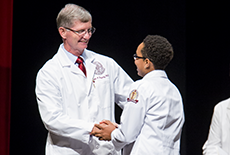Dean's Message, September 2014

It’s that time of year when I “make rounds” to each of our regional campuses for their all-faculty meetings and thank them for the incredible work they do to make our apprenticeship model work so well. I get a chance to update the faculty on what’s going on at the main campus and share the success stories of our clinical students. Here are some of the highlights of my comments to them:
- Curriculum redesign: We’re working hard to move toward a competency-based, patient-focused and fully integrated program. This started right after the LCME visit in 2011, and we rolled out the first component, Medicine 1, this summer for the Class of 2018. It combined anatomy, doctoring and a new “vision and values” component. Multiple teams are working on developing the systems-based components to come online in 2015. It’s expected that the medical students’ third year – the clerkship year – will remain structured as it is now. The plan is to also create opportunities for electives during the third year, to integrate the doctoring component and to rework the chronic-care-continuity component.
- The Class of 2018: Our 14th class arrived in late May and completed its first semester with the White Coat Ceremony on Aug. 22. We’re very pleased with our newest students and the energy they bring to the College of Medicine.
- How our students are doing in their clinical years: The Class of 2015 has done very well with USMLE Step 2 Clinical Knowledge. As of mid-August, 102 scores had been reported. Ninety-nine percent of those were passing marks, and 60 percent of them were above last year’s average (238). We continue to be impressed with how well our students do on Step 2, scoring well above the national average. It’s a direct reflection on the type of educational experiences they have with their clinical preceptors. For the Class of 2016, with 117 scores reported, we have a 96-percent pass rate and strong performances by our students. Given what’s at stake for students taking USMLE Step 1, we’re confident that we’re providing the support they need to be successful. The scores we’ve seen from our students are especially impressive in light of the changes made in the USMLE to raise the exam’s passing score.
- New clerkship evaluation system: Our Office of Medical Education has developed a refined competency-based assessment of students’ clinical performance. We ask preceptors to report how our students are meeting each of the expected competency milestones, and to determine at what level those students are performing based on the following scale: less than that of a typical third-year medical student, or on level with a new third-year, a progressing third-year, fourth-year or resident. We have found very strong correlations between preceptor evaluations and student success. Our regional campus deans and clerkship directors are using this information to provide feedback to students who are doing well and to those who may need to work on specific areas.
- Comments from program directors: Each year we survey residency program directors to see how our graduates are performing compared with other residents in those programs. We’re seeing impressive results. In many of the areas we stress, including professional behavior, interpersonal skills, medical knowledge and patient care, 90-99 percent rate superior to or comparable to their peers. Eighty-seven percent are rated in the top half of their class (a very fun statistic to share since I tell all of our students that only 50 percent can be in the top half here).
- Development and philanthropy: This has been a good year for the College of Medicine and our development team, with more than $4.3 million raised. That includes more than $2.9 million in planned gifts, more than $900,000 in cash, and pledges of more than $550,000. We appreciate our many friends who have supported us financially by contributing to student scholarships. Many faculty members have joined the President’s Club ($10,000 minimum contribution) through pledges, including many of our preceptors who donate their stipends to support our programs. This year we began a Primary Care Scholarship program, which seeks to provide $20,000 a year to 10 students in exchange for a commitment to return to Florida to do primary care in the future. In order to maintain the level of scholarship support, we obviously need to fund these new programs. Response from the students so far has been incredibly positive.
Our second-year students returned to campus last week and the undergrads are back, so the joy of driving on Tallahassee streets with little or no traffic has obviously faded. The tradeoff is that football season is here. Go Noles – and thanks again for your support.
John P. Fogarty, M.D.
Dean, Florida State University College of Medicine


